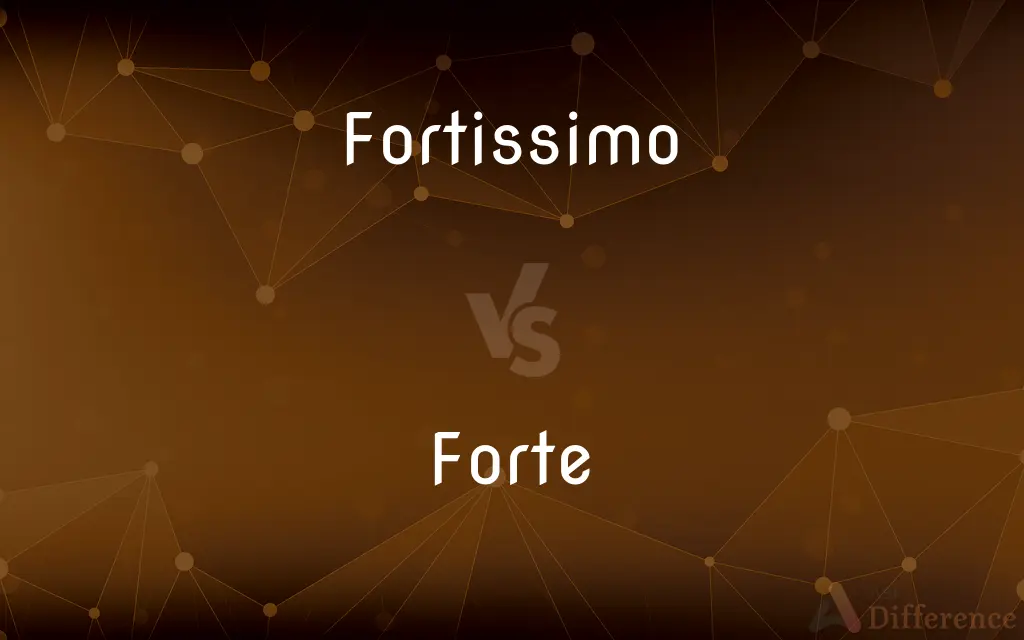Fortissimo vs. Forte — What's the Difference?
By Urooj Arif & Fiza Rafique — Updated on April 20, 2024
Fortissimo, indicated by "ff," denotes very loud dynamics in music, while forte, marked as "f," signifies a slightly lower level of loudness.

Difference Between Fortissimo and Forte
Table of Contents
ADVERTISEMENT
Key Differences
Fortissimo is a dynamic level in music that requires musicians to play very loudly, denoted by two f's ("ff") in sheet music. On the other hand, forte is also a loud dynamic but less intense than fortissimo, represented by a single "f."
In an orchestral setting, fortissimo passages demand maximum volume from the musicians, creating a powerful and enveloping sound. Whereas, forte passages, while still loud, are meant to be less overwhelming and serve as a standard for loudness without the extremity of fortissimo.
Composers use fortissimo to emphasize dramatic points or climaxes within a piece, highlighting these moments with significant auditory impact. In contrast, forte is often employed to convey strength or to stand out in a texture without necessarily reaching a peak intensity.
The transition from forte to fortissimo in a musical piece can significantly alter the mood and intensity, signaling a shift towards a more forceful expression. On the other hand, moving from a softer dynamic to forte can increase the energy and presence of the music without becoming overpowering.
Understanding the difference between fortissimo and forte is crucial for performers, as it affects not only the volume but also the emotional weight of the performance. While forte requires strong projection, fortissimo demands an even greater push, impacting the overall dynamics of the performance.
ADVERTISEMENT
Comparison Chart
Volume Level
Very loud
Loud but less than fortissimo
Symbol
Ff
F
Emotional Impact
Used for climactic and intense parts
Strong but not overpowering
Usage in Texture
Overpowering, dominates the texture
Prominent but blends with texture
Relative Intensity
Maximum intensity in standard dynamics
Lower intensity compared to fortissimo
Compare with Definitions
Fortissimo
Often associated with climactic moments in music.
The composer marked the climax with fortissimo to highlight its importance.
Forte
Balances volume and texture in musical compositions.
The forte dynamics balanced well with the gentle strings.
Fortissimo
Used to describe a passage where the music should be played at maximum volume.
The fortissimo passage allowed the trumpets to shine brilliantly.
Forte
Commonly used to maintain a presence in ensemble settings.
The forte dynamic helped the melody stand out.
Fortissimo
Indicates the peak loudness in a musical piece.
During the fortissimo, every player contributed to the resounding boom.
Forte
Marks passages that need emphasis but are not the focal point.
The section was marked forte to prepare for the upcoming crescendo.
Fortissimo
Requires energetic and forceful play from musicians.
The pianist’s fortissimo captivated the audience with its intensity.
Forte
Used to suggest a strong, assertive sound without overwhelming.
His forte playing was robust but controlled.
Fortissimo
A dynamic marking in music indicating very loud.
The orchestra hit the fortissimo section with thrilling power.
Forte
A dynamic marking in music indicating loudness but not to the extreme.
She played the forte passages with strong confidence.
Fortissimo
In a very loud manner. Used chiefly as a direction.
Forte
Something in which a person excels
“His forte was in defusing negative rumors before they ever exploded into news accounts” (Jane Mayer).
Fortissimo
A note, chord, or passage played fortissimo.
Forte
The strong part of a sword blade, between the middle and the hilt.
Fortissimo
(music) Indicating that the piece is played very loud.
Forte
A note, passage, or chord played forte.
Fortissimo
(music) The dynamic sign indicating that the piece should be played fortissimo. Abbreviation: ff.
Forte
In a loud, forceful manner. Used chiefly as a direction.
Fortissimo
Very loud; with the utmost strength or loudness.
Forte
A strength or talent.
He writes respectably, but poetry is not his forte.
Fortissimo
(music) with great loudness
Forte
The strong part of a sword blade, close to the hilt.
Fortissimo
Chiefly a direction or description in music
Forte
A passage in music to be played loudly; a loud section of music.
This forte marks the climax of the second movement.
Fortissimo
A direction in music; to be played very loudly
Forte
(music) Loud. Used as a dynamic directive in sheet music in its abbreviated form, "f.", to indicate raising the volume of the music. (Abbreviated in musical notation with an f, the Unicode character 1D191.)
This passage is forte, then there's a diminuendo to mezzo piano.
Forte
(music) Loudly.
The musicians played the passage forte.
Forte
The strong point; that in which one excels.
The construction of a fable seems by no means the forte of our modern poetical writers.
Forte
The stronger part of the blade of a sword; the part of half nearest the hilt; - opposed to foible.
Forte
Loudly; strongly; powerfully.
Forte
An asset of special worth or utility;
Cooking is his forte
Forte
(music) with great loudness
Forte
The stronger part of a sword blade between the hilt and the foible
Forte
Used chiefly as a direction or description in music;
The forte passages in the composition
Forte
Used as a direction in music; to be played relatively loudly
Common Curiosities
Can a piece transition directly from piano to fortissimo?
Yes, such a transition would create a dramatic contrast, enhancing the emotional effect.
What does fortissimo mean in music?
Fortissimo signifies a very loud dynamic level in music, often used for dramatic and intense passages.
Is fortissimo louder than forte?
Yes, fortissimo is a step above forte in terms of volume and intensity.
What role does forte play in an orchestral composition?
Forte provides a strong, prominent sound that supports the musical texture without overwhelming it.
Does forte always indicate loudness?
Yes, forte always indicates a degree of loudness, though it is not as intense as fortissimo.
Are fortissimo and forte the only dynamic markings in music?
No, there are several other dynamic markings ranging from very soft (pianissimo) to very loud (fortissimo).
How do performers approach a fortissimo passage?
Performers approach fortissimo with maximum energy and volume to achieve the desired dramatic effect.
How is forte different from fortissimo?
Forte is loud but less intense than fortissimo, which is marked as very loud.
How do composers use fortissimo to influence a musical piece?
Composers use fortissimo to highlight climactic moments and intensify the emotional impact of a piece.
What is the symbol for fortissimo?
The symbol for fortissimo is "ff."
Is it challenging to control dynamics from forte to fortissimo?
Yes, controlling the dynamics between these levels requires skill and sensitivity to maintain musicality.
How can a beginner musician practice achieving fortissimo?
A beginner can practice fortissimo by gradually increasing their volume control and strength in playing, focusing on maintaining sound quality at high volumes.
Can fortissimo be used in a solo performance?
Yes, fortissimo can be very effective in solo performances to convey maximum emotional expression.
How does the transition from forte to fortissimo affect the listening experience?
The transition from forte to fortissimo can dramatically increase the intensity and emotional impact of the music.
What is the symbol for forte?
The symbol for forte is "f."
Share Your Discovery

Previous Comparison
Objective vs. Initiative
Next Comparison
Herring vs. SpratAuthor Spotlight
Written by
Urooj ArifUrooj is a skilled content writer at Ask Difference, known for her exceptional ability to simplify complex topics into engaging and informative content. With a passion for research and a flair for clear, concise writing, she consistently delivers articles that resonate with our diverse audience.
Co-written by
Fiza RafiqueFiza Rafique is a skilled content writer at AskDifference.com, where she meticulously refines and enhances written pieces. Drawing from her vast editorial expertise, Fiza ensures clarity, accuracy, and precision in every article. Passionate about language, she continually seeks to elevate the quality of content for readers worldwide.














































